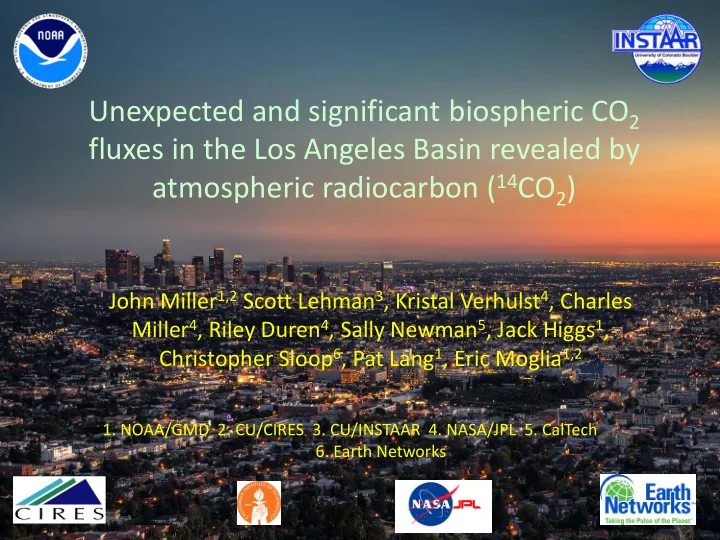

Unexpected and significant biospheric CO 2 fluxes in the Los Angeles Basin revealed by atmospheric radiocarbon ( 14 CO 2 ) John Miller 1,2 Scott Lehman 3 , Kristal Verhulst 4 , Charles Miller 4 , Riley Duren 4 , Sally Newman 5 , Jack Higgs 1 , Christopher Sloop 6 , Pat Lang 1 , Eric Moglia 1,2 1. NOAA/GMD 2. CU/CIRES 3. CU/INSTAAR 4. NASA/JPL 5. CalTech 6. Earth Networks
LA Megacities goals and our hypotheses “Develop and demonstrate measurement systems capable of quantifying trends in the anthropogenic carbon emissions of the Los Angeles Megacity (target: 10% change in Fossil Fuel CO 2 over 5 years).” 1. Despite a large network of CO 2 observations, quantifying CO 2 variations difficult without understanding biogenic contributions. 2. Biogenic contributions difficult without 14 C. 2
LA Basin 14 CO 2 sampling sites Niwot Ridge, Colorado 14 CO 2 sites background sites Continuous CO 2 sites 3
What you need to know about radiocarbon ( 14 C) 1. Produced via cosmic rays; absorbed by photosynthesis; decay with a half-life of ~6000 yrs. 2. Thus, fossil fuels have no 14 C; but 14 C bio ~ 14 C atmos. 3. CO 2 variations can be split into bio and fossil using 14 C. 4. Precious: [ 14 CO 2 ] ~ 400 x 10 -18 ; measured by Accelerator MS on 2 liters of air. 14 C/C expressed as ∆ = [( 14 C/C)/R std – 1]1000 in “per mil” 5.
Measurements of local and background CO 2 and ∆ 14 C allow us to determine C fos and C bio . CO 2 xs C obs = C bg + C fos + C bio No 14 C ~Atmospheric 14 C (-1000 per mil) (~ 40 per mil) 5
CO 2 and 14 CO 2 data show large variations with a clear fossil fuel contribution. Background More Fossil Fuel Background (NWR, MWO) USC Granada Hills CS Fullerton 6
Biospheric contribution to total CO 2 is substantial. C obs = C bg + C fos + C bio Larger enhancements in winter – less vertical mixing. Seasonally varying biosphere contribution with summer uptake. Summer biosphere drawdown is likely underrepresented because of enhanced mixing. Variability in CO 2 xs,bio and fos are likely dominated by changes in mixing. 7
Biogenic contribution appears highly seasonal 8
Why is CO 2 bio so high? 1. Ethanol in gasoline ~ 3% of fossil fuel emissions 2. Human respiration ~ 5% 3. Livestock respiration << 1% 4. Urban ecosystems: parks, lawns, golf courses, forests 5. Only urban ecosystems can explain negative C bio 9
Use fossil fuel inventory to estimate bio flux Allows separation of • atmospheric mixing and emissions. Source Annual mean flux (NEE) ~ • neutral (different than C bio ). Sink Seasonal minimum is in • summer, not spring, as expected for Mediterranean climate. F bio = C bio /C fos x F fos This suggests managed • ecosystems (e.g. lawns) are driving C bio , not native grass and forest Data Inventory (Vulcan) ecosystems. 10
Summary and implications 1. CO 2 xs ≠ CO 2 fos, even in L.A. 2. Remote-sensing and in situ approaches for urban CO 2 fluxes need to account for biospheric CO 2 . 3. CO 2 bio varies throughout the year, and likely year to year. Trend detection will be difficult. 4. Continued and widespread measurement of urban biosphere fluxes will be required to isolate the fossil fuel emissions signal. 11
12
Footprints 13
LANDSAT 30 m Vegetation (EVI) 14
LANDSAT 30 m EVI zoomed in shows even more. Google Earth (~50 cm) shows yet more. 15
Isotopic mixing analysis also shows substantial biospheric contribution throughout the year. Pure fossil: -1000 per mil Winter: -760 per mil CO 2 xs is 24% biogenic Summer: -830 per mil CO 2 xs is 17% biogenic 16
High correlation of Bio and Fossil components consistent with co-located distributed sources. • Fossil fuels (and ethanol), and human population are similarly distributed throughout the Basin. • Urban ecosystems may also be. • High correlation also suggests urban ecosystems and not mountain forest areas are responsible for Cbio variations. • N.B.: Correlation is analyzed in winter to avoid near zero CO 2 bio signal resulting from net photosynthesis. 17
Nighttime signals show more biogenic signal and small signals overall. Differences may reflect suppressed atmospheric mixing at night with lower fossil emissions. 18
Wintertime biospheric CO 2 fraction averages ~50% for regions; ~ 20% for cities N. America Europe Asia 56% 42% 50% 23% 41% 51% 19% 72% 21% 10% 52% 17% 20% 51% 45% Thanks to: K. Rozanski, M. Zimnoch (Poland); I. Levin (Germany); Morgan Lopez(France); L. Zhou (China); Korea-China 19 Center for Atmos. Res.
Atmospheric 14 CO 2 looks just like fossil CO 2 -2.5 per mil ∆ 14 C = 1 ppm CO 2 -fossil ESP DND MBO MSH Aircraft Tower ∆ 14 C CO 2-fos Miller et al, 2012 Includes ecosystems, oceans, nuclear Includes only fossil fuel power, cosmic rays, fossil fuel. 20
We can leverage our 14 C measurements to create a pseudo-continuous CO 2 fos time series. a. COxs:CO 2 ff ratios are fairly consistent (here for USC) b. Applying these to the USC COxs time series allows us to create “CO 2 fos Synthetic” 21
Recommend
More recommend